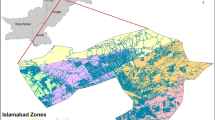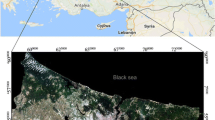Abstract
Rapid land use change has taken place over the last few decades in Istanbul. As most of the metropolitan areas, Istanbul faces increasing problems connected to increasing population and urbanisation. In this study, temporal changes of Istanbul’s land use/cover were defined using remotely sensed data and post classification change detection method. For the aim of the study, relevant information was derived from different dated Landsat Thematic Mapper (TM) satellite data by using Unsupervised Iterative Self-Organizing Data Analysis Technique (ISODATA) and results were examined with matrix analysis method. Ground truth data were used for the classification and accuracy assessment of the classification. Temporal changes of land use/cover classes of the mega city Istanbul between the years of 1992, 1997 and 2005 were examined for the management and decision making process. Landsat TM images were classified into six land use/cover types: forest-green area, bare land, water surface, road, urban area, and mining area. The results show that urban areas and road categories are increased greatly by 13,630 and 5,018ha, respectively, but forest-green areas decreased by 77,722ha over 13years between 1992 and 2005. The reason for the decrease in green areas is mainly because of development of unplanned urbanization and unavoidable migration.
Similar content being viewed by others
References
Anderson, J. R., Hardy, E. E., Roach, J. T., & Witmer, R. E. (1976). A land-use and land-cover classification system for use with remote sensor data. Washington, DC: US Geological Survey Professional Paper 964.
Bektas, F., & Goksel, C. (2005). Remote sensing and GIS integration for land cover analysis, A case study: Bozcaada Island. Water Science and Technology, 51(11), 239–244.
Dean, A. M., & Smith, G. M. (2003). An evaluation of per parcel land cover mapping using maximum likelihood class probabilities. International Journal of Remote Sensing, 24(14), 2905–2920.
European Commission (1998). Remote sensing of Mediterranean desertification and environmental changes (Resmedes). Luxembourg: Office for Official Publications of the European Communities.
Foody, G. M. (2002). Status of land cover classification accuracy assessment. Remote Sensing of Environment, 80, 185–201.
Fung, T., & Siu, W. (2000). Environmental quality and its changes, an analysis using NDVI. International Journal of Remote Sensing, 21(5), 1011–1024.
Guild, L. S., Cohen, W. B., & Kauffman, J. B. (2004). Detection of deforestation and land conversion in Rondônia, Brazil using change detection techniques. International Journal of Remote Sensing, 25(4), 731–750.
Jensen, J. R. (2004). Digital change detection. Introductory digital image processing: A remote sensing perspective (pp. 467–494). New Jersey: Prentice-Hall.
Kwarteng, A. Y., & Chavez, P. S. (1998). Change detection study of Kuwait City and environments using multi-temporal Landsat Thematic Mapper data. International Journal of Remote Sensing, 19, 1651–1662.
Lunetta, R. S., & Balogh, M. (1999). Application of multi-temporal Landsat 5 TM imagery for wetland identification. Photogrammetric Engineering and Remote Sensing, 65, 1303–1310.
Lyon, J. G., & Green, R. G. (1992). Use of aerial photographs to measure the historical extent of Lake Erie coastal wetlands. Photogrammetric Engineering and Remote Sensing, 58(9), 1355–1360.
Mas, J.-F. (1999). Monitoring land-cover changes: A comparison of change detection techniques. International Journal of Remote Sensing, 20, 1139–1152.
Masek, J. G., Lindsay, F. E., & Goward, S. N. (2000). Dynamics of urban growth in the Washington DC metropolitan area 1973–1996, from Landsat observations. International Journal of Remote Sensing, 21, 3473–3486.
Munyati, C. (2000). Wetland change detection on the Kafue Flats, Zambia, by classification of a multitemporal remote sensing image dataset. International Journal of Remote Sensing, 21(9), 1787–1806.
Rosenfield, G. H., & Fitzpatrick-Lins, K. (1986). A coefficient of agreement as a measure of thematic classification accuracy. Photogrammetric Engineering and Remote Sensing, 52, 223–227.
Serra, P., Pons, X., & Saurí, D. (2003). Post-classification change detection with data from different sensors: Some accuracy considerations. International Journal of Remote Sensing, 24(16), 3311–3340.
Singh, A. (1989). Digital change detection techniques using remotely-sensed data. International Journal of Remote Sensing, 6, 989–1003.
SIS, State Institute of Statistics (2006). www.die.gov.tr (accessed 14 July. 2006).
Sommer, S., Hill, J., & Megier, J. (1998). The potential of remote sensing for monitoring rural land use changes and their effects on soil conditions. Agriculture, Ecosystems and Environment, 67, 197–209.
Verbyla, D. L. (1995). Satellite remote sensing of natural resources. Boca Raton: CRC (ISBN 1-55670-107-4).
Young, S. S., & Wang, C. Y. (2001). Land-cover change analysis of China using global-scale Pathfinder AVHRR Landcover (PAL) data, 1982–92. International Journal of Remote Sensing, 22(8), 1457–1477.
Yuan, F., Sawaya, K. E., Loeffelhoz, B. C., & Bauer, M. E. (2005). Land cover classification and change analysis of the twin cities (Minnesota) Metropolitan Area by multitemporal Landsat remote sensing. Remote Sensing of Environment, 98, 317–328.
Yuanbo, L., Nishiyama, S., & Yano, T. (2004). Analysis of four change detection algorithms in bi-temporal space with a case study. International Journal of Remote Sensing, 25(11), 2121–2139.
Author information
Authors and Affiliations
Corresponding author
Rights and permissions
About this article
Cite this article
Sanli, F.B., Balcik, F.B. & Goksel, C. Defining temporal spatial patterns of mega city Istanbul to see the impacts of increasing population. Environ Monit Assess 146, 267–275 (2008). https://doi.org/10.1007/s10661-007-0078-4
Received:
Accepted:
Published:
Issue Date:
DOI: https://doi.org/10.1007/s10661-007-0078-4




